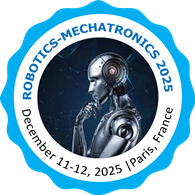sessions/tracks
1.Robotics
Robotics is an interdisciplinary field that involves the design, construction, operation, and application of robots. Robots are automated machines capable of performing tasks either autonomously or under human control. Combining elements of mechanical engineering, electrical engineering, computer science, artificial intelligence, and more, robotics seeks to create systems that can assist, augment, or replace humans in various activities. A robot is a programmable machine designed to carry out a series of actions automatically. These actions may range from simple repetitive tasks to complex operations requiring sensory feedback and decision-making. Robots can mimic human behaviors, interact with their environment, and adapt to changing conditions.
ROBOTICS-MECHATRONICS 2025 | Robotics 2025 | Mechatronics 2025| Robotics conference 2025 | Mechatronics summit 2025| Robotics event 2025 | Industrial Robotics events 2025| AI in Robotics | Robotics Innovation| Robotics workshops|
2. Role of Automation in Robotics
Automation is a transformative force that has fundamentally reshaped industries, production processes, and everyday life. In robotics, automation is the backbone that empowers machines to perform tasks with minimal or no human intervention. The integration of automation into robotics not only enhances efficiency and productivity but also extends the capabilities of robots beyond simple mechanized tools to intelligent systems capable of autonomous decision-making and adaptive behavior. The synergy between automation and robotics is crucial for achieving high precision, safety, scalability, and cost-effectiveness in diverse applications ranging from manufacturing to healthcare, logistics, exploration, and beyond.
ROBOTICS-MECHATRONICS 2025 | Robotics 2025 | Mechatronics 2025| Robotics conference 2025 | Mechatronics summit 2025| Robotics event 2025 | Industrial Robotics events 2025| AI in Robotics | Robotics Innovation| Robotics workshops|
3. Functional devices of Robotics
Robotics is an interdisciplinary science that integrates various functional devices to create intelligent machines capable of performing complex tasks autonomously or semi-autonomously. These functional devices are the fundamental building blocks of any robotic system, enabling the robot to perceive its environment, process data, make decisions, and act effectively. Understanding these devices is crucial for designing, building, and programming robots suited for diverse applications such as manufacturing, healthcare, exploration, and service industries.
ROBOTICS-MECHATRONICS 2025 | Robotics 2025 | Mechatronics 2025| Robotics conference 2025 | Mechatronics summit 2025| Robotics event 2025 | Industrial Robotics events 2025| AI in Robotics | Robotics Innovation| Robotics workshops|
4. Robotics and Mechatronics
Robotics and mechatronics are closely intertwined multidisciplinary fields that combine principles from mechanical engineering, electronics, computer science, and control engineering to design, develop, and operate intelligent machines and systems. While robotics focuses primarily on the creation and application of robots—autonomous or semi-autonomous machines that perform specific tasks—mechatronics emphasizes the integration of mechanical systems with electronic control and intelligent software to produce smart, adaptable devices. Together, these fields drive innovation in automation, enhancing productivity, precision, and functionality in countless applications across industry, healthcare, transportation, and everyday life.
ROBOTICS-MECHATRONICS 2025 | Robotics 2025 | Mechatronics 2025| Robotics conference 2025 | Mechatronics summit 2025| Robotics event 2025 | Industrial Robotics events 2025| AI in Robotics | Robotics Innovation| Robotics workshops|
5. Future Scope of Humanoid Robots
Humanoid robots designed to resemble and mimic human form and behaviour represent one of the most fascinating and ambitious areas of robotics research and development. With their human-like structure, including limbs, sensory organs, and the ability to interact naturally with the environment, humanoid robots hold immense potential across various domains. The future scope of humanoid robots is vast, promising transformative impacts on industries, society, and everyday life.
ROBOTICS-MECHATRONICS 2025 | Robotics 2025 | Mechatronics 2025| Robotics conference 2025 | Mechatronics summit 2025| Robotics event 2025 | Industrial Robotics events 2025| AI in Robotics | Robotics Innovation| Robotics workshops|
6. Role of 3d Printing in Robotics
3D printing, also known as additive manufacturing, is fundamentally transforming the robotics industry by offering innovative ways to design, prototype, and manufacture robotic components. Unlike conventional manufacturing methods, which often rely on subtractive processes such as milling, cutting, or molding, 3D printing builds objects layer by layer directly from digital designs. This paradigm shift is enabling engineers and researchers to overcome long-standing challenges in fabricating complex geometries, lightweight structures, and highly customized parts that were previously impossible or prohibitively expensive to produce.
ROBOTICS-MECHATRONICS 2025 | Robotics 2025 | Mechatronics 2025| Robotics conference 2025 | Mechatronics summit 2025| Robotics event 2025 | Industrial Robotics events 2025| AI in Robotics | Robotics Innovation| Robotics workshops|
7. Multi-Robot Systems
Multi-Robot Systems (MRS) refer to coordinated groups or teams of robots working collaboratively to achieve common goals or perform complex tasks that are beyond the capabilities of a single robot. These systems harness the collective power of multiple autonomous or semi-autonomous robots, enabling enhanced efficiency, robustness, and scalability in various applications. Multi-robot systems embody concepts from robotics, artificial intelligence, control theory, and distributed computing, making them a vibrant and rapidly evolving area of research and development.
ROBOTICS-MECHATRONICS 2025 | Robotics 2025 | Mechatronics 2025| Robotics conference 2025 | Mechatronics summit 2025| Robotics event 2025 | Industrial Robotics events 2025| AI in Robotics | Robotics Innovation| Robotics workshops|
8. Marine Robotics
Marine robotics is a specialized branch of robotics focused on the design, development, and deployment of robotic systems that operate in aquatic environments, including oceans, seas, lakes, and rivers. These robots are engineered to perform a wide variety of tasks underwater or on the water surface, ranging from exploration and research to maintenance and surveillance. Marine robotics integrates principles from mechanical engineering, electrical engineering, computer science, oceanography, and environmental science to address the unique challenges of operating in harsh and often unpredictable marine environments.
ROBOTICS-MECHATRONICS 2025 | Robotics 2025 | Mechatronics 2025| Robotics conference 2025 | Mechatronics summit 2025| Robotics event 2025 | Industrial Robotics events 2025| AI in Robotics | Robotics Innovation| Robotics workshops|
9.Human-Robot Collaboration
Human-Robot Collaboration (HRC) refers to the interaction and cooperation between humans and robots working together in shared environments to accomplish tasks more efficiently, safely, and intuitively. Unlike traditional automation, where robots operate in isolation or in fenced-off areas, HRC emphasizes the integration of robotic systems as active partners alongside humans, complementing human skills with robotic precision, strength, and endurance. This paradigm shift is transforming industries, workplaces, healthcare, and everyday life by enabling seamless synergy between human intelligence and robotic capabilities.
ROBOTICS-MECHATRONICS 2025 | Robotics 2025 | Mechatronics 2025| Robotics conference 2025 | Mechatronics summit 2025| Robotics event 2025 | Industrial Robotics events 2025| AI in Robotics | Robotics Innovation| Robotics workshops|
10. Bio-inspired Robotics
Bio-inspired robotics is a fascinating field that draws inspiration from biological systems, such as animals, plants, and microorganisms, to design and develop robots that mimic nature’s strategies for movement, sensing, adaptation, and problem-solving. By studying the principles of biomechanics, neural control, and evolutionary adaptations, researchers create robots with enhanced capabilities, efficiency, and versatility that often surpass traditional mechanical designs. This approach bridges biology and engineering, leading to innovative robotic systems that can operate in complex, unstructured environments
ROBOTICS-MECHATRONICS 2025 | Robotics 2025 | Mechatronics 2025| Robotics conference 2025 | Mechatronics summit 2025| Robotics event 2025 | Industrial Robotics events 2025| AI in Robotics | Robotics Innovation| Robotics workshops|
11. Defense Robotics
Defense robotics is a rapidly advancing field within robotics focused on developing autonomous and semi-autonomous robotic systems to support military and defense operations. These robots are designed to enhance the capabilities, safety, and efficiency of armed forces by performing a wide range of tasks such as surveillance, reconnaissance, combat support, logistics, and explosive ordnance disposal. Integrating cutting-edge technologies including artificial intelligence, machine learning, advanced sensors, and ruggedized hardware, defense robotics is transforming modern warfare by reducing human risk and increasing operational effectiveness.
ROBOTICS-MECHATRONICS 2025 | Robotics 2025 | Mechatronics 2025| Robotics conference 2025 | Mechatronics summit 2025| Robotics event 2025 | Industrial Robotics events 2025| AI in Robotics | Robotics Innovation| Robotics workshops|
12. Robotics in Healthcare and Rehabilitation
Robotics in healthcare and rehabilitation is an emerging and transformative field where robotic technologies are integrated into medical practices to improve patient care, enhance surgical precision, assist in physical therapy, and facilitate recovery. By combining advancements in robotics, artificial intelligence, sensor technology, and biomechanics, healthcare robotics provides innovative solutions for diagnosis, treatment, rehabilitation, and patient monitoring. This interdisciplinary field is revolutionizing how medical professionals deliver care, offering new opportunities for improving outcomes and quality of life for patients.
ROBOTICS-MECHATRONICS 2025 | Robotics 2025 | Mechatronics 2025| Robotics conference 2025 | Mechatronics summit 2025| Robotics event 2025 | Industrial Robotics events 2025| AI in Robotics | Robotics Innovation| Robotics workshops|
13. Industrial Automation and Smart Manufacturing
Industrial automation and smart manufacturing represent the convergence of advanced technologies to transform traditional production processes into highly efficient, flexible, and intelligent systems. Industrial automation involves the use of control systems, such as robots, programmable logic controllers (PLCs), and computer numerical control (CNC) machines, to perform manufacturing tasks with minimal human intervention. Smart manufacturing builds upon this by integrating cyber-physical systems, the Internet of Things (IoT), big data analytics, artificial intelligence (AI), and cloud computing to enable real-time monitoring, predictive maintenance, and adaptive decision-making.
ROBOTICS-MECHATRONICS 2025 | Robotics 2025 | Mechatronics 2025| Robotics conference 2025 | Mechatronics summit 2025| Robotics event 2025 | Industrial Robotics events 2025| AI in Robotics | Robotics Innovation| Robotics workshops|
14. Robotics in Agriculture and Food Processing
Robotics in agriculture and food processing is an innovative field that applies robotic technologies to enhance productivity, efficiency, and sustainability in farming and food manufacturing. As global populations rise and environmental challenges intensify, traditional agricultural practices face increasing pressure to produce more food with fewer resources. Robotics offers transformative solutions by automating labor-intensive tasks, improving precision, and enabling data-driven decision-making throughout the agricultural value chain—from planting and harvesting to food sorting and packaging.
ROBOTICS-MECHATRONICS 2025 | Robotics 2025 | Mechatronics 2025| Robotics conference 2025 | Mechatronics summit 2025| Robotics event 2025 | Industrial Robotics events 2025| AI in Robotics | Robotics Innovation| Robotics workshops|
15. Tactile and Haptic Technologies in Robotics
Tactile and haptic technologies are critical components of modern robotics that enable machines to sense, interpret, and respond to touch and force stimuli, closely mimicking human sensory and motor capabilities. These technologies bridge the gap between physical interaction and robotic perception, allowing robots to perform delicate, precise, and context-aware tasks in a variety of applications, from healthcare and manufacturing to virtual reality and teleoperation. By integrating tactile sensors and haptic feedback systems, robots can interact more naturally and safely with their environment and human operators.
ROBOTICS-MECHATRONICS 2025 | Robotics 2025 | Mechatronics 2025| Robotics conference 2025 | Mechatronics summit 2025| Robotics event 2025 | Industrial Robotics events 2025| AI in Robotics | Robotics Innovation| Robotics workshops|
16. Robotics for Disaster Response and Recovery
Robotics for disaster response and recovery is a rapidly growing field dedicated to deploying robotic systems in emergency situations to save lives, minimize damage, and support recovery efforts. Natural disasters such as earthquakes, floods, hurricanes, and wildfires, as well as man-made catastrophes like industrial accidents and terrorist attacks, often create hazardous environments that are unsafe or inaccessible for human responders. Robots equipped with advanced sensing, mobility, and communication capabilities play a crucial role in augmenting human efforts by conducting search and rescue, assessing damage, delivering supplies, and assisting in recovery operations.
ROBOTICS-MECHATRONICS 2025 | Robotics 2025 | Mechatronics 2025| Robotics conference 2025 | Mechatronics summit 2025| Robotics event 2025 | Industrial Robotics events 2025| AI in Robotics | Robotics Innovation| Robotics workshops|
17. Educational Robotics and STEM Outreach
Educational robotics and STEM (Science, Technology, Engineering, and Mathematics) outreach have become vital components in modern education, aimed at inspiring and equipping students with essential skills for the future. Robotics education leverages hands-on, interactive learning by engaging students in designing, building, and programming robots. This practical approach fosters problem-solving, creativity, and critical thinking while making STEM subjects more accessible and exciting. STEM outreach initiatives utilize robotics to spark interest in science and engineering among diverse communities, promoting inclusivity and preparing the next generation of innovators.
ROBOTICS-MECHATRONICS 2025 | Robotics 2025 | Mechatronics 2025| Robotics conference 2025 | Mechatronics summit 2025| Robotics event 2025 | Industrial Robotics events 2025| AI in Robotics | Robotics Innovation| Robotics workshops|
18. Advanced Sensors and Actuators for Robotics
Advanced sensors and actuators are fundamental components that empower robots to perceive, interact with, and manipulate their environment effectively. Sensors gather crucial data about the robot’s surroundings and internal state, enabling awareness and informed decision-making, while actuators execute physical movements and operations based on control signals. As robotics technology evolves, the demand for highly precise, reliable, and versatile sensors and actuators has grown, driving innovations that enhance robot autonomy, dexterity, and adaptability across a wide array of applications
ROBOTICS-MECHATRONICS 2025 | Robotics 2025 | Mechatronics 2025| Robotics conference 2025 | Mechatronics summit 2025| Robotics event 2025 | Industrial Robotics events 2025| AI in Robotics | Robotics Innovation| Robotics workshops|
19. Robotics in Autonomous Vehicles
Robotics plays a pivotal role in the development and operation of autonomous vehicles (AVs), which include self-driving cars, trucks, drones, and other robotic transport systems. Autonomous vehicles rely on sophisticated robotic technologies to perceive their surroundings, make real-time decisions, and navigate safely without human intervention. Integrating advanced sensors, control algorithms, and artificial intelligence, robotics transforms traditional vehicles into intelligent machines capable of revolutionizing transportation, improving safety, and enhancing mobility.
ROBOTICS-MECHATRONICS 2025 | Robotics 2025 | Mechatronics 2025| Robotics conference 2025 | Mechatronics summit 2025| Robotics event 2025 | Industrial Robotics events 2025| AI in Robotics | Robotics Innovation| Robotics workshops|
20. Artificial Intelligence in Robotic Process Automation (RPA)
Robotic Process Automation (RPA) refers to the use of software robots or “bots” to automate repetitive, rule-based tasks typically performed by humans within business processes. While traditional RPA excels at automating structured and predictable workflows, the integration of Artificial Intelligence (AI) elevates RPA by enabling the automation of complex, cognitive, and unstructured tasks. This combination—often called Intelligent Process Automation (IPA) or Cognitive RPA—allows organizations to achieve higher efficiency, accuracy, and scalability in their operations.
ROBOTICS-MECHATRONICS 2025 | Robotics 2025 | Mechatronics 2025| Robotics conference 2025 | Mechatronics summit 2025| Robotics event 2025 | Industrial Robotics events 2025| AI in Robotics | Robotics Innovation| Robotics workshops|
21. Robotics for Environmental Monitoring and Conservation
Robotics has emerged as a powerful tool for environmental monitoring and conservation, offering innovative solutions to observe, analyze, and protect natural ecosystems. Equipped with advanced sensors, autonomous navigation, and data processing capabilities, robots can operate in diverse and often challenging environments—ranging from dense forests and oceans to arid deserts and polluted urban areas. By providing precise, real-time data and performing tasks that are difficult, dangerous, or impossible for humans, robotics is revolutionizing the way scientists and conservationists understand and safeguard the environment.
ROBOTICS-MECHATRONICS 2025 | Robotics 2025 | Mechatronics 2025| Robotics conference 2025 | Mechatronics summit 2025| Robotics event 2025 | Industrial Robotics events 2025| AI in Robotics | Robotics Innovation| Robotics workshops|
22. Micro and Nano Robotics
Micro and nano robotics refer to the design, fabrication, and application of robots at microscopic and nanoscopic scales—ranging from a few micrometers down to nanometers (one-billionth of a meter). These tiny robots operate in environments inaccessible to conventional robots, such as inside the human body, microfluidic systems, or within complex materials. The field combines principles from robotics, nanotechnology, materials science, biology, and medicine, offering groundbreaking potential for healthcare, manufacturing, environmental monitoring, and beyond.
ROBOTICS-MECHATRONICS 2025 | Robotics 2025 | Mechatronics 2025| Robotics conference 2025 | Mechatronics summit 2025| Robotics event 2025 | Industrial Robotics events 2025| AI in Robotics | Robotics Innovation| Robotics workshops|
23. Robotic Systems in Logistics and Supply Chain Management
The logistics and supply chain industry is undergoing a profound transformation driven by the adoption of robotic systems. Robotics in this sector refers to the use of automated machines and intelligent robots to streamline the movement, storage, handling, and delivery of goods throughout the supply chain. By improving efficiency, accuracy, and speed, robotic systems help businesses meet increasing customer demands, reduce operational costs, and enhance overall supply chain resilience.
ROBOTICS-MECHATRONICS 2025 | Robotics 2025 | Mechatronics 2025| Robotics conference 2025 | Mechatronics summit 2025| Robotics event 2025 | Industrial Robotics events 2025| AI in Robotics | Robotics Innovation| Robotics workshops|
24. Advances in Robot Design and Control
Robot design and control are fundamental aspects of robotics engineering that determine how effectively robots can perform their intended tasks. Over the years, significant advances in both areas have driven the development of more versatile, precise, adaptable, and intelligent robotic systems. These improvements span hardware innovations, sophisticated control algorithms, sensor integration, and artificial intelligence, enabling robots to operate in increasingly complex and dynamic environments across industries such as manufacturing, healthcare, exploration, and service robotics.
ROBOTICS-MECHATRONICS 2025 | Robotics 2025 | Mechatronics 2025| Robotics conference 2025 | Mechatronics summit 2025| Robotics event 2025 | Industrial Robotics events 2025| AI in Robotics | Robotics Innovation| Robotics workshops|
25. Robotics in Entertainment and Gaming
Robotics has increasingly become a dynamic force within the entertainment and gaming industries, enhancing user experiences and enabling new forms of interactive and immersive content. Robots—ranging from animatronics and humanoids to autonomous drones and AI-driven characters—are integrated into theme parks, movies, live performances, gaming platforms, and virtual reality environments. This fusion of robotics with entertainment technology is reshaping how audiences engage with stories, games, and interactive media.
ROBOTICS-MECHATRONICS 2025 | Robotics 2025 | Mechatronics 2025| Robotics conference 2025 | Mechatronics summit 2025| Robotics event 2025 | Industrial Robotics events 2025| AI in Robotics | Robotics Innovation| Robotics workshops|















